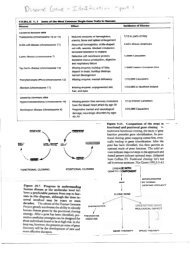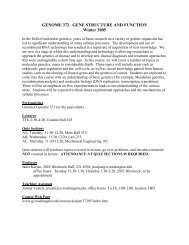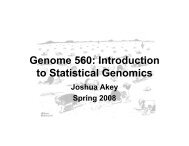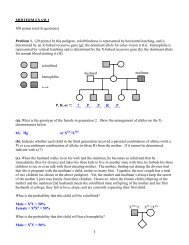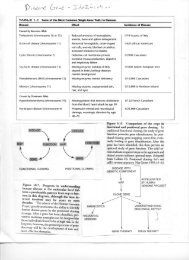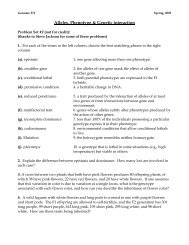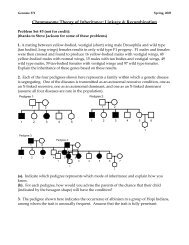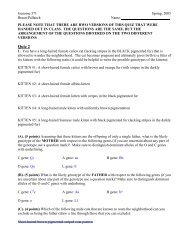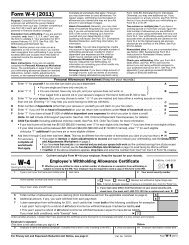Special topic: Metagenomics - Genome Sciences
Special topic: Metagenomics - Genome Sciences
Special topic: Metagenomics - Genome Sciences
Create successful ePaper yourself
Turn your PDF publications into a flip-book with our unique Google optimized e-Paper software.
TTG-8 [2]<br />
TTG-9 [5]<br />
TTG-10 [39]<br />
Biofuels & Termites<br />
T. primitia termite group [1]<br />
Spirochaeta (Treponema) caldaria, M71240.1<br />
T. pallidum and amino acid fermentors<br />
T. bryantii and saccharolytic strains<br />
Spirochaeta coccoides SPN1, AJ698092.1<br />
TSG-1 [1]<br />
Spirochaeta aurantia, AY599019.1<br />
Other<br />
TSG-2 [3]<br />
TSG-3 [1]<br />
Spirochaetaceae<br />
TLG-1 [1]<br />
Leptospiraceae<br />
Leptospira<br />
Fibrobacter<br />
Candidate order TG3-1 [32]<br />
Proteobacteria [9]<br />
Deferribacteres [1]<br />
Candidate order TFG-1 [14]<br />
Candidate order TG3-2 [3]<br />
Bacteroidetes [14]<br />
Chlorobi and gut clones [1]<br />
Acidobacteria [10]<br />
Candidate phylum Endomicrobia [1]<br />
Cyanobacteria and gut clones [2]<br />
Candidate phylum ZB3 [3]<br />
Firmicutes [16]<br />
Aminanaerobia [1]<br />
Can biofuels alleviate 1,289the unambiguously energy aligned crisis? and filtered Ethanol nucleotide positions. can contribute Branching to energy and environmental<br />
goals<br />
The path forward for biofuels: cellulosic ethanol.<br />
Treponema<br />
Phylum Fibrobacteres [49]<br />
Figure 1 | Source and composition of the bacterial community analysed.<br />
a, Diagram of the gut tract extracted from the Nasutitermes host insect. The<br />
anterior of the P3 paunch was incised as indicated (dotted line) with a<br />
syringe needle. The luminal contents from about 165 specimens were<br />
collected and pooled for nucleic acid and protein analyses. b, Phylogenetic<br />
diversity of the P3 luminal microbiota. From a PCR-based inventory and<br />
from the metagenome libraries, 1,703 almost full-length and 41 full-topartial<br />
16S rRNA gene sequences were used in a maximum-likelihood<br />
analysis (RAxML). The number of distinct P3 luminal community<br />
phylotypes contained within each grouping is given in brackets (a total of<br />
216 operational taxonomical units sharing at least 99% sequence identity);<br />
black shading denotes that at least one of these phylotypes was represented<br />
within the PCR inventory or metagenome libraries (red dots). White shading<br />
denotes reference groups having no representation in this or other public<br />
inventories derived from termite gut. The phylogram was constructed from<br />
pattern confidence is visualized as follows: no circle, more than 50%;<br />
open circle, more than 70%; filled circle, more than 90%. Scale bar indicates<br />
10% estimated sequence divergence. See Supplementary Tables 1, 2 and 11<br />
and Supplementary Figs 2–9 for accession numbers and detailed<br />
phylogenetic analyses.<br />
0.10<br />
GH5 cellulases, GH94 cellobiose or cellodextrin phosphorylases<br />
GH51 endoglucanase/arabinofuranosidases, and a smaller number<br />
of GH8, GH9, GH44, GH45 and GH74 endoglucanases. In contrast<br />
gene modules corresponding to the catalytic domains of GH6 and<br />
GH48 family endoglucanases and cellobiohydrolases, key components<br />
of several well-studied microbial cellulase systems, were absent<br />
1 mm<br />
©2007 Nature Publishing Group<br />
Diverse endoglucanases<br />
(Treponema<br />
Treponema and Fi brobactere s)<br />
(see Table 1 and<br />
Supplementary Figs 10 and 11)<br />
GH94 phosphorylases<br />
(Treponema<br />
Treponema)<br />
(see Table 1)<br />
Fe-only H2ases (Treponema<br />
Treponema)<br />
(see Table 1 and<br />
Supplementary<br />
Figs 16–19)<br />
Wood-Ljungdahl pathway<br />
of CO2-reduction (Treponema<br />
Treponema)<br />
(see Supplementary<br />
Figs 20–23)<br />
Wood polysaccharides<br />
Cellulose Xylan<br />
Hydrolysis<br />
Fermentation<br />
Acetate<br />
Acetate<br />
3rd proctodeal segment (P3)<br />
Hexose oligomers Pentose oligomers<br />
Central metabolism intermediates<br />
H 2 +CO 2<br />
Diverse endoxylanases<br />
(Treponema)<br />
(seeTable 1 and<br />
Supplementary Figs 12 and 13)<br />
Diverse glycosidases<br />
(Treponema<br />
Treponema)<br />
(see Table 1)<br />
Atmospheric N 2<br />
Ammonium<br />
Microbial protein<br />
Diverse<br />
nitrogenases<br />
(Treponema and<br />
Fibrobacteres)<br />
Absorbed by termite as dominant substrate for energy and biosynthesis<br />
Figure 2 | Model of nutritional symbiosis-relevant metabolism by<br />
Nasutitermes P3 luminal bacteria. Wood is triturated by the insect’s<br />
mandibles into small particles and predigested by poorly studied upstream<br />
processes before transit into the P3 compartment. The P3 lumen is<br />
dominated by diverse species of Treponema (Spirochaetes) and<br />
Fibrobacteres. There was no evidence for methanogenesis or lignin<br />
degradation in the metagenomic data set.<br />
56



